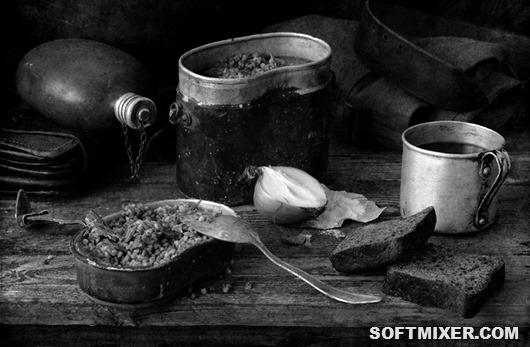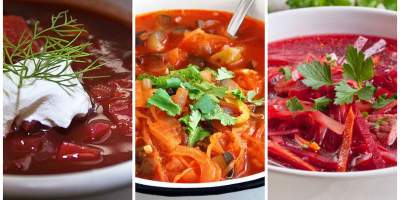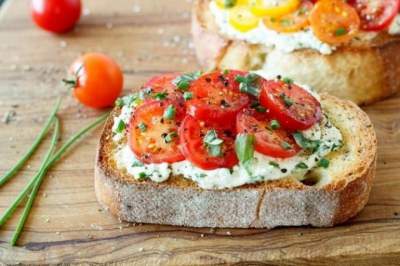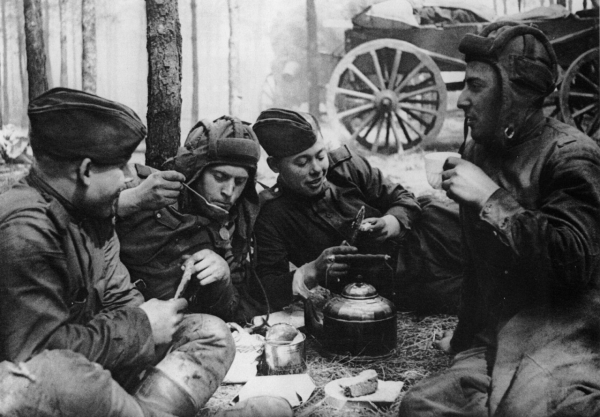
My grandfather went through the Great Patriotic War, he served in armor. When I was a teenager, he told me a lot about the war, about the life of soldiers, etc. In one of the warm days of August he made me a “gruel”, as he put it “on the recipe 1943” – it was such a hearty meal (for many soldiers, the last in their lives) was fed to the tank crews in the early morning in front of one of the greatest tank battles of world war II – “the Battle of Kursk” …
And here is the recipe:
-Take 500-600 grams of brisket on the bone.
-Cut off the meat and throw the bones to boil for 15 minutes in water (about 1.5 – 2 liters).
-Add in boiling water millet (250 to 300 grams) and cook until tender.
-Peel 3-4 potatoes, cut it in large cubes and throw into the pot
-In a skillet fry the meat part of the bacon with finely chopped 3-4 heads of onions, and add to the pan, cook for another 2-3 minutes. It turns out that if a thick soup, or liquid porridge. A delicious and hearty dish…
Of course, in order to list all the dishes wartime, not enough no newspaper columns, so today I will tell you only about the most important gastronomic events of that great epoch.
My memories of the great Patriotic war (like most representatives of modern generation, did not find the military time) based on the stories of the older generation. The culinary component of the war – is no exception.
“Millet porridge with garlic”
Need for porridge millet, water, vegetable oil, onion, garlic and salt. 3 cups of water take 1 Cup of grits.
Pour water into a saucepan, sprinkle with cereal and set on fire. Fry in vegetable oil onion. Once the water in the pan boils, pour it with our zazharku and sprinkle with salt porridge. She still cooked for 5 minutes, and we meanwhile, clean and finely chop a few cloves of garlic. Now we have to remove the pan from the heat, add in the cereal, garlic, stir, cover the pan with a lid and wrap in a coat: let steamed. Such porridge turns out delicate, soft, fragrant.
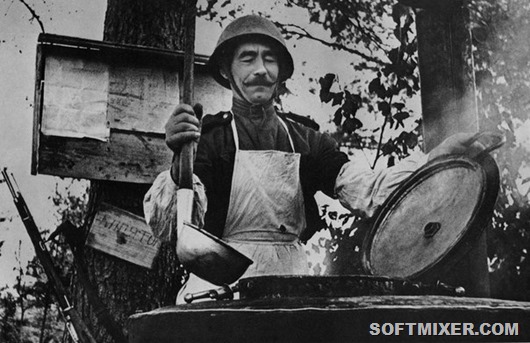
“Rear Bag”
Writes Vladimir UVAROV from Ussuriysk, – “this dish is often prepared in a dashing time of war and in the post-war years with my grandmother, now deceased. In the pot it was putting an equal amount of sauerkraut and purified, sliced potatoes. Then grandma poured water so that it covers the cabbage-potato mixture.
Then put the pot on the fire to stew. And 5 minutes before ready to add to the pot fried in vegetable oil shredded onion, a few Bay leaves and pepper if necessary to taste, and salt. When everything is ready, you should cover your pot with a towel and allow to stew for half an hour.
This dish, I’m sure everyone will love it. Grandma’s recipe we used often and in rich times and ate this “hodgepodge” with pleasure – though not in the pot, and the usual pan it was extinguished”
“Pasta “Baltic” nautically with meat”
According to the neighbor-the veteran-paratrooper to testify (battle man! in their right mind, in her 90 years for 3 km per day runs, swimming in any weather), this recipe was used extensively in the holiday menu (on the occasion of the successful battles or victories of the fleet) the ships of the Baltic fleet during World war II :
In the same proportion take the pasta and meat (preferably ribs), onions (roughly a third of the weight of the meat and pasta)
-the meat is boiled until tender and cut into cubes (bouillon fashionable to use on the soup)
the macaroni are boiled until tender
-sprinted onion in a pan until Golden color
-meat, onion and pasta mix, spread on a baking sheet (you can add a bit of broth) and put in oven for 10-20 minutes at a temperature of 210-220 degrees.
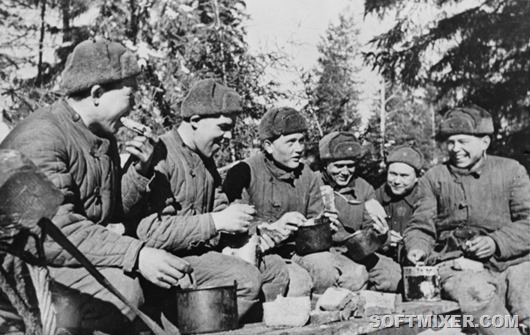
“Carrot tea”
Peel the carrots rubbed on a grater, dried and fried it (I think dried) on a baking sheet in the oven with the chaga, then pour boiling water over. The carrots turned out sweet tea, but chaga was given a special flavor and nice dark color.
Salads siege of Leningrad
In the besieged Leningrad existed prescription brochures and practical manuals that helped people to survive in a besieged city: “the Use of food crops tops and storing it for future use”, “Herbal tea and coffee substitutes”, “Cook of wild spring plants, baked goods, soups and salads,” etc.
Many of these publications made by the Leningrad Botanical Institute, talked not only about how to prepare certain herbs, but where better to collect. Give a couple of recipes of the time.
Salad of sorrel. To prepare the salad crushed 100 grams of sorrel in a wooden Cup, pour 1-1,5 teaspoon of salt, pour 0,5–1 spoon of vegetable oil or 3 tablespoons soy yogurt, then stir.
Salad of dandelion leaves. Collect 100 grams of fresh green dandelion leaves, take 1 teaspoon salt, 2 tablespoons vinegar, if there is, add 2 teaspoons of vegetable oil and 2 teaspoons of granulated sugar.
The bread war
One of the most important factors that helps to survive, to defend their Homeland, along with the weapons was and remains the bread – a measure of life. Striking confirmation of this is the Great Patriotic war.
Many years have passed and it will take many more, will be written new books about the war, but returning to the topic, the descendants will ask the eternal question: why Russia stood on the brink and won? We helped her to come to a great Victory?

Much credit for this people, which provided our soldiers, soldiers, residents of the occupied territories and the blockade of food, primarily bread and crackers.
Despite the enormous difficulties, the country in 1941-1945 provided the army and home front workers with bread, sometimes solving the most difficult problems associated with the lack of raw materials and production capacity.
Baking bread is usually used, the production capacity of bakeries and bakeries, which are centrally allocated flour and salt. The orders of the military units was carried out as a matter of priority, all the more so for the population of bread baked a little, and power, as a rule, were free.
However, there was exceptions.
So, in 1941 to provide military units, focused on Rzhev direction, local resources are not enough, and the supply of bread from the rear was difficult. To solve the quartermaster corps proposed to use the historic experience of creating outdoor incinerator stoves from locally available materials – clay and brick.
For the device the furnace was required in clayey soil with an admixture of sand and a platform with a ditch or a pit depth of 70 mm., This pizza oven was built usually for 8 h, 8-10 h, then dried, and then was ready to bake up to 240 kg of bread for 5 turns.
The bread front 1941-1943.
In 1941, near the upper reaches of the Volga was the initial line. Under a steep Bank of the river smoked earthen dishes, placed sarota. Here, in the first months of the war created the earthen (mostly they are installed in the ground) of the baking oven. These furnaces were of three types: common ground; covered inside a thick layer of clay; lined inside with brick. They make pan and hearth bread.
Where possible, furnaces were made of clay or brick. The front of Moscow bread was baked in bakeries and bakeries in stationary.

Veterans of the Moscow battles told how in the ravine the foreman handed out to soldiers hot bread that was brought on the boat (like a sledge, only without runners pulled by dogs. The foreman was in a hurry, over a ravine swept low green, blue, purple tracer missiles. Near exploded mines. The soldiers in “haste” to eat of the bread and sipped the tea, ready to re-attack…
Member of the Rzhev operation V. A. Shestowsky recalled: “After fierce fighting, our share in the spring of 1942 were taken to the village Capkova. Although this village was at some distance from the fighting, but the food was poorly established case. For food we cooked soup and village women brought him bread “é” baked from potatoes and bran. From that day we began to experience relief.
How to cook bread “é”? Potatoes cooked, cleaned, passed through a meat grinder. He posted the mix on the Board, sprinkled with bran, cooled. Added bran, salt, quickly knead the dough and put it in a greased form, which were placed in the oven.
Bread “Stalingrad”
During the Great Patriotic war the bread was valued on a par with military weapons. It was not enough. Rye flour was scarce, and bread baking for the soldiers of the Stalingrad front were widely used barley flour.
Especially tasty with the use of barley flour to make breads, prepared on sourdough. So, rye bread, composed of 30% barley flour, almost not inferior in quality to pure rye.
Cooking bread wholemeal flour mixed with barley significant process changes are not required. The dough with the addition of barley flour was somewhat more dense and longer to make.
“The siege” bread
In July-September 1941, Nazi troops reached the outskirts of Leningrad and lake Ladoga, taking multi-million city in a blockade ring.
Despite suffering the rear showed miracles of courage, bravery, love for the Fatherland. The siege of Leningrad was not an exception here. To ensure that soldiers and the population of the city at the bakeries was organized the production of bread from the meager reserves, and when they ended, the flour were delivered to Leningrad on the “Road of life”.
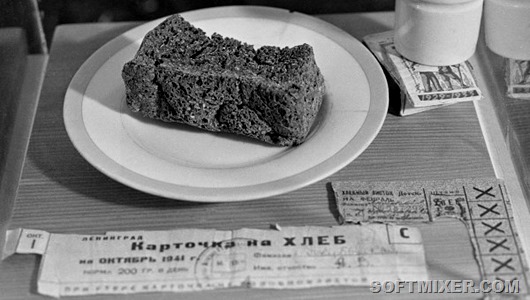
A. N. Yukhnevich – the oldest worker of the Leningrad bakery – said at the Moscow school №128 the Lesson of Bread on the composition of the siege of loaves: 10-12% — this rye flour wholemeal, the rest is cake, meal, flour brooms with equipment and floor of vybiyka bags, food cellulose, needles. Exactly 125 g daily value Holy siege of black bread.
Bread temporarily occupied areas
About how to survive and starving the local population of the occupied territories during the war, it is impossible to hear and read without tears. All the food were robbed from people by the Nazis, taken to Germany. Ukrainian, Russian and Belarusian mothers suffered themselves, but even more – seeing their children suffering, hungry and sick relatives, wounded soldiers.
What they lived, what they ate beyond the comprehension of present generations. Every living blade of grass, a twig with seeds, hulls of frozen vegetables, debris and cleaning – everything went in. And often even the smallest extracted value of human life.
In hospitals in the German-occupied territories of the wounded soldiers were given two spoons of millet porridge a day (bread was not). Cooked “grout” made of flour – soup in a jelly. Soup of peas or barley for the hungry people was the occasion. But most importantly – the people lost their usual and especially for them of expensive bread.
Measures this deprivation is not, and the memory of them should live for the edification of posterity.
The “bread” of Nazi concentration camps
From the memoirs of a former member of the anti-fascist Resistance, a disabled group D. I. Ivanisheva from the city of Novozybkov of the Bryansk region: “the Bread of war, can not leave indifferent any man, especially one who has experienced terrible privations during the war – hunger, cold, humiliation.
I, by fate, had to undergo many Nazi camps and concentration camps. We, the prisoners of concentration camps, we know the price of bread and worship him. So I decided to tell something about the bread for prisoners of war. The fact is that the Nazis were baked for Russian prisoners of war special bread special recipe.
It was called “the Austen-Brot” and was approved by the Reich Ministry of food supply in the Reich (Germany) on 21 December 1941, “only Russian”.
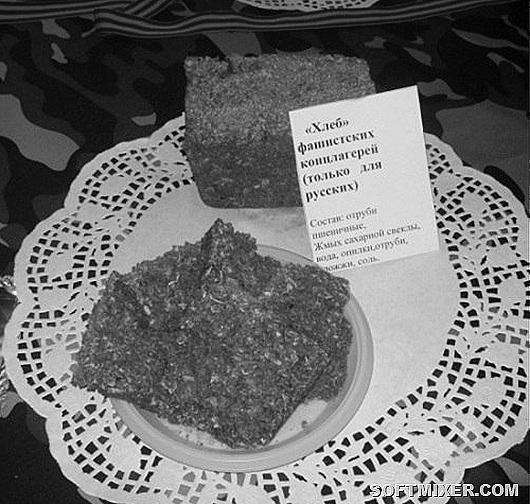
Here is his recipe:
scrap sugar beet – 40%,
bran – 30%,
sawdust – 20%,
pulp and flour of leaves or straw – 10%.
In many concentration camps the POWs were not given this “bread”.
Bread rear and front
On the instructions of the government had launched production of bread for the population in the conditions of huge deficit of raw materials. Moscow technological Institute of food industry has developed a working recipe of bread, which is special orders, instructions, instructions were brought to managers of public catering enterprises. In inadequate supply of flour for bread making was widely used potatoes and other products.
The bread is often baked in the front under the open sky. Soldiers of the division of mining Donbass I. Sergeev said: “I will say about the combat bakery. The bread was 80% of the total power of the fighter. Somehow it was necessary to give bread the shelves within four hours. Drove to the site, cleared the deep snow and then, among the snowdrifts, the ground folded oven. Flooded, dried it and baked bread.”
Dried rasparenny roach
My grandmother told me how they ate dried vobla. For us it is a fish designed for beer. And the grandmother said that vobla (roach called it for some reason), also issued on cards. It was sooo dry and sooooo salty.
Put the fish with the peel in a saucepan, filled with boiling water, closed the lid. Fish had to stand until cool. (Probably better to do in the evening, and not enough patience.) Then boiled the potatoes, got out of the pan fish, a steamed, soft and not salty. Cleaned and eaten with potatoes. I tried. Grandma did once. Know and really enjoy!
Pea soup.
The evening was filled in the pot the peas with water. Sometimes peas filled with pearl barley. The next day, the peas were placed in a military field kitchen and cooked. Until cooked peas, in the pan the bacon was overcooked onions and carrots. If it was not possible to make zazharku, laid. As cooked peas added the potatoes, then zazharku and at last pawned stew.
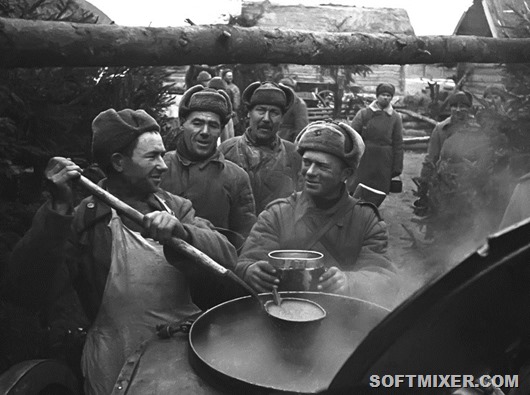
“Makarovka” Option number 1 (perfect)
Frozen stew finely cut or crumbled, pan fried onions (if available, you can add the carrots), then added to the stew, a little water, bring to a boil. Eating : meat and gusterna” divided by the number of consumers, and the broth turns the dipped bread slices, so the dish so called.
Option # 2
Took fat or raw lard, add in the fried onions (like in the first recipe), diluted with water, brought to a boil. Ate also as in embodiment 1.
The recipe according to the first embodiment is familiar to me (tried for diversity in the campaigns), but its name and the fact that it was invented during the war (probably earlier) I did not occur.
Nicholas noted that by the end of the war to feed at the front became better and better fed, although as he put it “it is empty, then thickly”, his words – it happened that on some days the food is not picked up, especially in time of onset or protracted battles, and then handed out put over the past few days rations.
Children of war
The war was brutal, bloody. Grief entered every home and every family. Went to the front fathers, brothers, and the children were left alone, – shares memories of A. S. Vidin. – “In the early days of the war they had enough to eat. And then they, along with her mother went picked up the ears, rotten potatoes, in order to feed themselves. And most boys were at the bench. They wouldn’t hit the arm of the machine and tripped the boxes. For 24 hours a day doing the rounds. Sometimes I slept on those boxes.
Children of war very quickly matured and began to help not only parents, but also the front. Women, left without husbands, did everything for the front: knit mittens, and sewed underwear. Not lagged behind them and the children. They had sent the parcel, which invested his drawings, depicting the peaceful life, paper, pencils. And when the soldier received a parcel of children, he cried… But it inspired his soldiers with renewed energy went into battle, the attack to beat the Nazis, took the childhood of the kids.
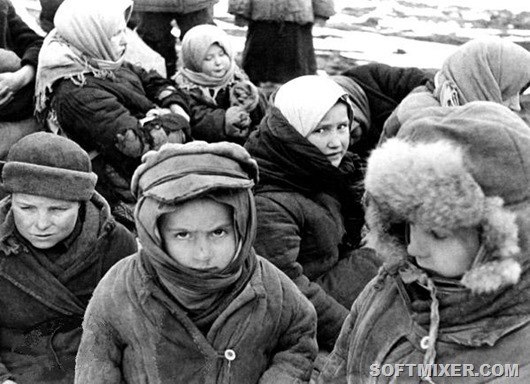
A former head teacher of the school №2 V. S. Bolotsky has told how they were evacuated early in the war. In the first echelon with the parents she has not got. Later learned that it was bombed. With the second echelon, the family was evacuated to Udmurtia “Life of evacuated children was very, very heavy.
If the local people still had something, then we ate the pellets with sawdust, – said Valentina Sergeevna. She told me what was the favorite dish of children of war: into the boiling water ran grated unpeeled raw potatoes. This was so yummy!”
And once more about a soldier’s porridge, food and dreams…. Memories of veterans of the great Patriotic War:
G. KUZNETSOV:
“When I came on 15 July 1941 the regiment, our cook, uncle Vanya, shot down from the boards table, in the woods, fed me a whole pot of buckwheat porridge with bacon. Nothing tastes better edali”
Ivan SHYLA :
“The war I always dreamed about what would eat plenty of bread: then its not always enough. And two more wishes was to get warm (in a soldier’s overcoat about guns has always been chilly) but to sleep”
Vladimir SHINDIN, Chairman of the Council of veterans :
“From the front of the kitchen will always remain the most delicious of two dishes: buckwheat porridge with stewed meat and pasta nautically”.
***
Nearing a major holiday in modern Russia. For the generation who knows the Great Patriotic war only on films, it is associated more with guns and missiles. I want to remember the main weapon of our Victory.
During the war, when the famine was as common as death and a dream of a dream, and a cherished gift could serve most miserable in today’s presentation thing – a piece of bread, a Cup of barley flour or, for example, a chicken egg, the food is very often the equivalent of human life and were valued on a par with military weapons…
